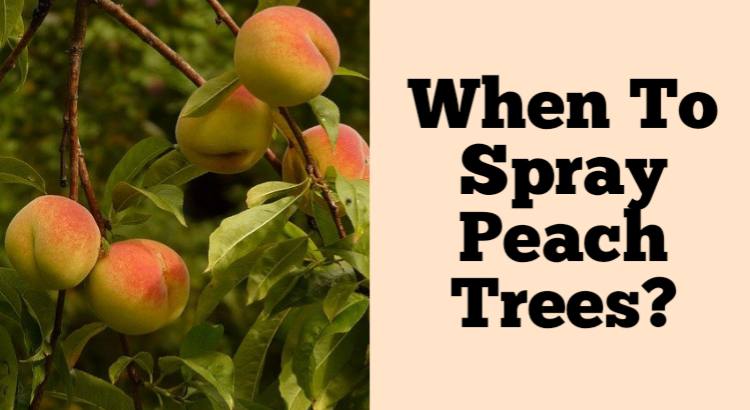Peach trees are one of the most popular fruit trees in North America and some of the best-tasting peaches come from home orchards. If you have a peach tree, you will want to keep it healthy and make sure it is producing good fruit.
One way to do this is by spraying your peach tree with a fungicide. When should you spray? How often? And what kind of spray can be used on your tree?
When to Spray Peach Trees for Insects and Disease.
Inspect the trees and look for signs of insect infestation, such as holes or webbing in the leaves.
You can also use a soap mixture to spray the tree’s trunk and branches to kill off any insects hiding there.
If you notice spots on your peach tree, it may be infected with crown gall disease; remove any affected twigs immediately so they do not spread to other areas of the plant.
Spray the tree before bud swell, which occurs in late winter and early spring.
If a peach tree is sprayed in early spring, the spray will get rid of any insects that are overwintering on the tree.
Spraying during bud swell or bloom will cause bitter taste problems and may decrease fruit size.
You should spray trees when they have no leaves on them so that you can see where you have sprayed and not accidentally spray other plants or parts of your garden.
Use a dormant oil spray to prevent insects such as aphids and mites.
It’s non-toxic, safe to use on fruit trees, ornamentals and vegetables, even if they’re in bloom.
Dormant oil sprays are applied when the tree is dormant (no leaves) or just starting to bud out.
Mix 2 1/2 tablespoons of liquid horticulture oil with one gallon of water.
This mixture will kill the psyllid and its offspring on contact. The best time to spray is at bud swell, which occurs when tiny buds begin to push out of the bark.
Spray your peach trees thoroughly with this solution, making sure that all exposed parts of the tree are coated in it.
If you miss any spots, they could become infested later on in the season when they’re more mature and harder to reach with a spray bottle or hose attachment (such as an air blower).
Use an insecticide to treat fruit trees with peach tree borers, plum curculio or Japanese beetles.
Once you’re sure your trees are in the dormant stage, spray them with an insecticide to get rid of borers, curculios and beetles.
Spray when buds are beginning to swell but before leaf growth begins (this would be around late March or early April).
Spray on a warm, sunny day that has no rain in the forecast for at least 24 hours after application.
Spray after blossoms have dropped from fruit trees so that you don’t kill bees as they pollinate future crops.
For example, use carbaryl, or Sevin, or malathion.
- Spray peach trees before the buds swell in late March or early April. Peach tree borers lay eggs under the bark of twigs, and if you don’t treat them when they’re small, the larvae will tunnel into the tree and kill it.
- Spray Japanese beetles with carbaryl, or Sevin, or malathion.
You can also spray the lawn with bifenthrin or permethrin, which will kill both Japanese beetles and larvae.
Follow the label instructions for mixing and application.
It’s important to use the correct amounts of fertilizer and follow the label’s recommendation for spraying. If you don’t, your plants could become damaged or burned.
Also follow all other directions that are included on the product labels—for example, don’t apply pesticides when rain is expected in less than two hours, and always avoid spraying on windy days.
Use a fungicide spray on peaches grown in overly wet or humid areas prone to fungal diseases such as brown rot, leaf curl and twig canker.
- Fungicides are important for peach trees, especially if you live in an overly wet or humid area that’s prone to fungal diseases such as brown rot, leaf curl and twig canker.
- A fungicide spray can help protect your peaches from these diseases.
- You should use a fungicide on peaches grown in overly wet or humid areas prone to fungal diseases such as brown rot, leaf curl and twig canker.
For example, use captan or chlorothalonil.
- Captan is a systemic fungicide. It’s labeled for use on peaches and nectarines, and also apples, pears, roses and many other ornamental plants.
- Chlorothalonil is a non-systemic fungicide that can be used to prevent powdery mildew on both peaches and nectarines (but not cherries).
Spraying peach trees will keep them healthy and ensure you get good fruit production from your trees.
This can be done every few weeks or months, depending on how much you’re spraying for other pests, as well as the amount of rainfall in your area.
Conclusion
All in all, spraying peach trees is really just another way of caring for them. The more effort you put into keeping them healthy, the better your fruit production will be.
So, keep applying that spray every time as recommended by your local extension office. And remember: you can always go back and do it again if necessary.

